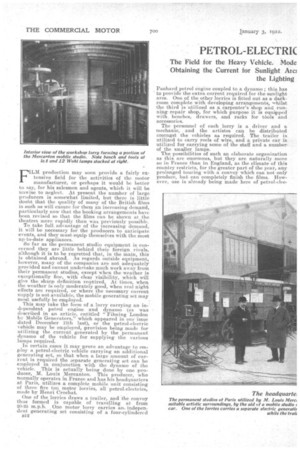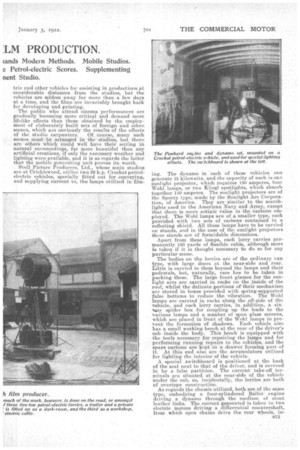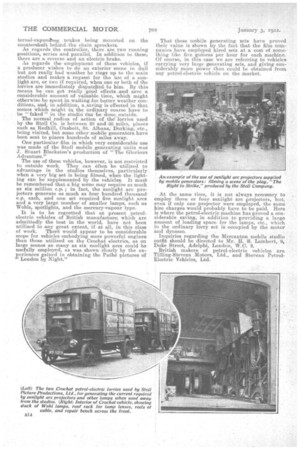PETROL-ELECTRIC :LYI PRODUCTION.
Page 12

Page 13

Page 14

If you've noticed an error in this article please click here to report it so we can fix it.
•
FILM production may soon provide a fairly extensive field for the activities of the motor manufacturer, or perhaps it would be better to say, for his salesmen and agents, which it will be unwise to neglect. At present the number of large producers is somewhat limited, but there is little doubt that the quality of many of the British films is such as will ensure for them an increasing demand, particularly now that the booking arrangements have been revised so that the films can be shown at the theatres more rapidly than was previously possible.
To take full. advantage of the increasing demand, it will be necessary for the producers to anticipate events, and they must equip themselves with the most up-to-date appliances. So far as the permanent studio equipment is concerned they are little behind their foreign rivals, although it is to be regretted that, in the main, this is obtained abroad. As regards outside equipment, however, many of the companies are not adequately provided and cannot undertake much work away from their permanent studios, except when the weather is exceptionally fine, with clear visibility, which will give the sharp definition required. At times, when the weather is only moderately good, when real night effects are required, or where the necessary current supply is not available; the mobile generating set may most usefully be employed. This may take the form of a lorry carrying an independent petrol engine and dynamo (as was described in an article, entitled "Filming London by Mobile Generators," which appeared in our issue dated December 13th last), or the petrol-electric vehicle may be employed, provision being made for utilizing the current generated by the permanent dynamo of the vehicle for supplying the various lamps required.
In certain cases it may prove an advantage to employ a petrol-electric vehicle carrying an additional generating set, so that when a large amount of current is required the separate generating set -can be employed in conjunction with the dynamo of the vehicle. This is actually being done by one producer, M. Louis Mercanton. This producer, who normally operates in France and has his headquarters at Paris, utilizes a complete mobile unit consisting of three five ton motor lorries, all petrol-electries, made by Henri Croehat. .
One of the lorries draws a trailer, and the convoy thus formed is capable of travelling at from '20-25 m.p.h. One motor lorry carries an. independent generating set consisting of a four-eylindered
Panhard petrol engine coupled to a dynamo ; this has to provide the extra current required for the sunlight arcs. One of the other lorries is fitted out as a darkroom complete with developing arrangements, whilst the third is utilized as a carpenter's shop and running repair shop, for which purpose it is equipped with. benches, drawers, and racks for tools and accessories.
The personnel of each lorry is a driver and a mechanic, and the artistes can be distributed amongst the vehicles as required. The trailer is utilized to carry reels of wire, and a private ear is utilized for carrying some of the staff and a numberof the smaller lamps. The possibilities of such an elaborate organization as this are enormous, but they are naturally more so in France than in England, as the climate of this country restricts, for the greater part of the year, any prolonged touring with a convoy which can not only produce, but can completely finish the films. However, use is already being made here of petrol-elec tric and other vehicles for assisting in productions at considerable distances from the studios, but the vehicles are seldom away for more than a few days at a time, and the films are invariably brought back for developing and printing. The public who attend cinema performances are gradually becoming more critical and demand more lifelike effects than those obtained by the employment of elaborately built sets of foreign and other, scenes, which are obviously the results of the efforts of the studio carpenters. Of course, many such scenes must be arranged in the studios, but there are others which could well have their setting in natural surroundings, far more beautiful than any artificial creations, if only the necessary weather and lighting were available, and it is as regards the latter that the mobile generating unit proves its worth.
. Stoll Picture Producers, Ltd., whose main studios are at Cricklewood, utilize two 20 h.p. Crochat petrolelectric vehicles, specially fitted out for -conveying, and supplying current to, the lamps utilized in film ing. The dynamo in each of these vehicles can generate 15 kilowatts, and the capacity of each is one sunlight projector, which requires 150 amperes, four Wohl lamps, or two Kliegl spotlights, which absorb together 140 amperes. The sunlight projectors are of the Sperry type, made by the Sunlight Arc Corporation, of America. They are similar to the searchlights used in the American Navy and Army, except that there is more actinic value in the carbons employed. The Wohl lamps are of a smaller type, each provided with two sets of carbons contained in a reflecting shield. All these lamps have to be carried on stands, and in the case of the sunlight projectors these stands are of formidable dimensions.
Apart from these lamps, each lorry carries permanently 150 yards of flexible cable, although more is taken if it is thought necessary to do so for any particular scene. The bodies on the lorries are of the ordinary van type, with large doors at the near-side and rear. Little is carried in them beyond the lamps and their pedestals, but, naturally, care has to be taken in packing these. The large front glasses for the sunlight arcs are carried in racks on the inside of the roof, whilst the delicate portions of their mechanism are stored in boxes provided with spring-supported false bottoms to reduce the vibration. The Wohl lamps are carried in racks along, the off-side of th i e vehicle, and each lorry carries, n addition, a six way spider box for coupling up the leads to the various lamps and a number of spun glass screens, which are placed in 'front of the Wohl lamps to prevent the formation of shadows. Each vehicle also has a small working bench at the rear of the driver's cab inside the body. This bench is equipped with the tools necessary for repairing the lamps and for performing running repairs to the vehicles, and the spare carbons are kept in a drawer forming part of it. At :this end also are the accumulators utilized for lighting the interior of the vehicle.
A special _switchboard is positioned at the back of the seat next to that of the driver, and is covered in by a false partition. The current take-off terminals are situated at the near-side of the vehicle under the cab, as, incjdentally, the lorries are both of overtype constructilm.
As regards the chassis.utilized, both are of the same type, embodying a four-cylindered Ballot engine driving a dynamo through the medium of stout leather links. The current generated is taken to two electric motors driving a differential countershaft, from which open chains drive the rear wheels, in,
ternal-expancimgbrakes being mounted on the countershaft behind.the chain sprockets.
As regards the controller, there are two running positions, series and parallel. In addition to these, there are a. reverse and an electric brake.
As regards the employment of these vehicles, if a producer wishes to do an exterior scene in dull but not really bad weather he rings up to the main studios and makes a request for the use of a sunlight arc, or two if required, when one or both of the lorries are immediately dispatched to him. By this means he can get really good effects and save a considerable amount of valuable time, which might otherwise be spent in waiting for better weather conditions, and, in addition, a ,saving is effected in that scenes which might in the ordinary course have to be "faked" in the studio Can be done outside.
The normal radius of action of the lorries used by the Stoll Co. is between 20 and 30 miles, places such as Redhill, Oxshott, St. Albans, Dorking, etc., being visited, but some other mobile generators have been sent to places hundreds of miles away.
One particular-film in which very considerable use was made of the Stoll mobile generating units was J. Stuart Blackston's production of "The Glorious Adventure."
The use of these vehicles, however, is not restricted to outside work. They can often be utilized to advantage in the studios themselves, particularly when a very big set is being filmed, when the lighting can be supplemented by the vehicles. It must be remembered that a big scene may require as much as six million c.p. ; in fact, the sunlight arc projectors generate as much as four hundred thousand• c.p. each, and one set required five sunlight arcs and a very large number of smaller lamps, such as Wohls, spotlights, and the mercury-vapour type.
It is to be regretted that at present petrolelectric vehicles of British manufacture; which are admittedly the best in the world, have not been utilized to any great extent, if at all, in this class of work. There' would appear to be considerable scope for vehicles embodying more powerful engines than those utilized on the Crochat electrics, as on large scenes as many as six sunlight arcs could be usefully employed, as was shown clearly by the experiences gained in obtaining the Pathe pictures of "London by Night." That these mobile generating sets have proved their value is shown by the fact that the film companies have employed hired sets at a cost of something like five guineas per hour for each machine. Of course, in this case we are referring to vehicles carrying very large generating sets, and giving considerably more power than could be obtained from any petrol-electric vehicle on the Market.
At the same time, it is not always necessary to employ three or four sunlight arc projectors, but, even if only one projector were employed, the same hire charges would probably have to be paid. Here is where the petrol-electric machine has proved a considerable saving, in addition to providing a large amount of loading space for the lamps, etc., which in the ordinary lorry set is occupied by the motor and dynamo.
Inquiries regarding the Mercanton mobile studio outfit should be directed to Mr. H. S. Lambert, 9, Duke Street, Adelphi, London, W.C. 2.
British makers of petrol-electric vehicles. are Tilling-Stevens Motors, Ltd., and Stevens PetrolElectric Vehicles, Ltd.




























